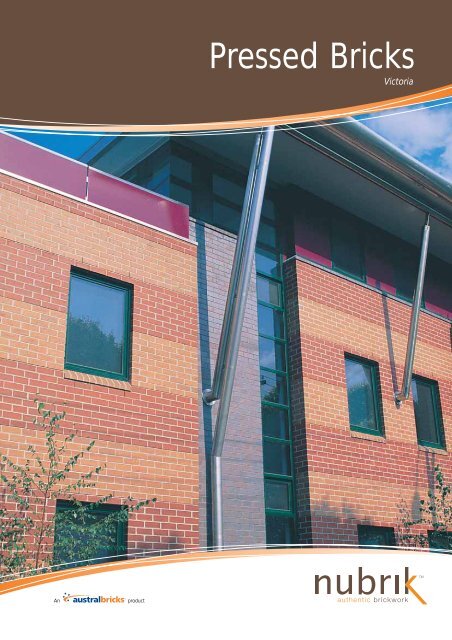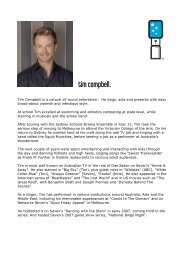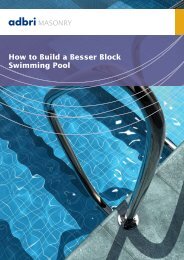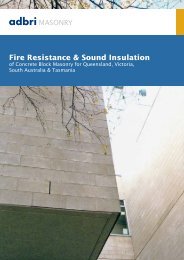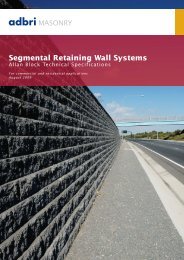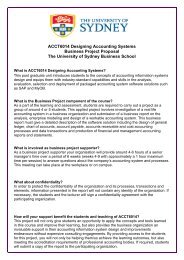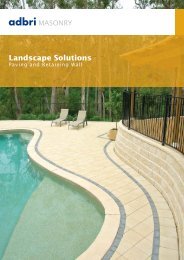You also want an ePaper? Increase the reach of your titles
YUMPU automatically turns print PDFs into web optimized ePapers that Google loves.
<strong>Pressed</strong> <strong>Bricks</strong><br />
Victoria<br />
An<br />
product
Contents<br />
Build in the Benefits with Brick 5<br />
Building a sustainable future 6<br />
Choosing <strong>Bricks</strong>? Start here 8<br />
The Nubrik Classic230 Series 10<br />
<strong>Pressed</strong> Red<br />
<strong>Pressed</strong> Terracotta<br />
<strong>Pressed</strong> Cream<br />
<strong>Pressed</strong> Grey<br />
<strong>Pressed</strong> Manganese<br />
<strong>Pressed</strong> Coffee<br />
The Nubrik Aspect290 Series 14<br />
Park Avenue Pearl<br />
Flat Iron Grey<br />
Dakota Coffee<br />
Brooklyn Brownstone<br />
Nubrik Shaped <strong>Bricks</strong> 16<br />
Helpful Hints 18<br />
All Nubrik bricks are made the traditional way, using<br />
carefully selected clays that are moulded on century-old<br />
brick presses and fired in high-temperature kilns.<br />
The result is an authentic brick with solid strength and<br />
timeless, individual character.
Build in the Benefits with Brick<br />
Building in brick is cost effective<br />
As a general rule, a brick house costs less to build. How can that be? Brick supply and<br />
laying is <strong>com</strong>petitive; you aren’t locked into a single supplier or a proprietary system.<br />
All building trades are familiar with brick. But most of all, brick doesn’t need expensive<br />
finishes such as paint or render.<br />
Brick is creative<br />
<strong>Bricks</strong> are red or cream or brown, right? Wrong! Take a fresh look at today’s bricks –<br />
metallics, high-gloss glazes, smooth monochromatics, pastels, and more. Whatever the<br />
design, we have the brick for you. And bricks blend beautifully with other premium<br />
building materials such as stainless steel and natural stone.<br />
Brick saves time, effort (and money)<br />
Brick is the original low maintenance material. Does it get any lower than zero!<br />
Face brickwork needs no painting, no cleaning, no patching, no refinishing. Over the years,<br />
that adds up to a considerable saving of time and money.<br />
Brick homes are economical to run<br />
Home buyers know that bricks keep you warmer in winter and cooler in summer. The heavy<br />
mass of brickwork is an essential <strong>com</strong>ponent in energy-saving passive designs. <strong>Bricks</strong> have<br />
what architects call “high thermal mass” which <strong>com</strong>bines with orientation, ventilation and<br />
insulation to save energy summer and winter. That’s good for your budget … and great for<br />
our environment.<br />
Brick is quiet and healthy<br />
The world seems to be getting noisier, so thank goodness for the quiet calm of a brick<br />
house. These aren’t paper thin walls that let in the neighbour’s lawnmower or noisy traffic.<br />
The solid mass of bricks dampens sound. You can also breathe easy with bricks. They don’t<br />
give off any emissions or chemical nasties.<br />
<strong>Bricks</strong> is safe and secure, resists termites and fire<br />
There’s something <strong>com</strong>forting about the strength and solidity of brick. It stands up against<br />
the ravages of weather and time, and resists fire, which is why many insurance <strong>com</strong>panies<br />
reserve their best rates for brick homes. Brick is also very unattractive to termites which<br />
prefer chewier materials such as timber.<br />
Brick offers many happy returns<br />
The real estate market prefers bricks. That’s because the market knows and trusts brick as<br />
Australia’s favourite home building material. Your new home will not only be a blue chip<br />
investment, it will be<strong>com</strong>e home to successive families for generations to <strong>com</strong>e.<br />
5
Building a sustainable future<br />
Austral <strong>Bricks</strong> is a GreenSmart Leader, a program<br />
sponsored by the Housing Industry Association to promote<br />
environmental performance in Australia’s building industry.<br />
6
You can breathe easy.<br />
It’s brick.<br />
Brick lowers your carbon footprint<br />
Research has proved, and designers agree, that mass is an essential <strong>com</strong>ponent in<br />
energy-saving passive designs. <strong>Bricks</strong> have what architects call “high thermal mass” which<br />
helps stabilise temperature movements. When <strong>com</strong>bined with the other passive design<br />
factors – orientation, ventilation and insulation – brickwork’s high thermal mass will reduce<br />
dependence on artificial heating and cooling and lower your energy consumption.<br />
“<strong>Bricks</strong> are a good news story<br />
for the environment,”<br />
says Cameron McCormick,<br />
Austral <strong>Bricks</strong> Victorian<br />
quarrying and environmental<br />
manager.<br />
“Our new state-of-the-art<br />
Victorian plant is setting<br />
records for its efficient use of<br />
energy and natural resources.<br />
For you, the consumer,<br />
building in brick is an<br />
effective technology with<br />
an outstanding record.”<br />
<strong>Bricks</strong> last and last<br />
Long after less durable materials have been replaced, long after paint has flaked and sealers<br />
have perished, your bricks will still be performing impeccably. That’s why they are often the<br />
last material to be replaced in a renovation or extension.<br />
<strong>Bricks</strong> are fully reusable<br />
They are one of the very few materials that can be reused (not just recycled) with all their<br />
original qualities intact. And if they are consigned to landfill, bricks are chemically inert and<br />
can’t pollute groundwater or contaminate soil.<br />
<strong>Bricks</strong> are good for life<br />
Not only is a brick house cost-effective to build, but over its long life you will save even<br />
more in maintenance, repairs, refinishing and operating costs such as heating and cooling.<br />
<strong>Bricks</strong> are all natural<br />
They are made from clay and shale, two of our planet’s most abundant minerals.<br />
No chemicals, no fillers, no environmental nasties.<br />
Brick manufacture is highly efficient<br />
Austral <strong>Bricks</strong> new brick super-plant located near Craigieburn uses the latest high-tech<br />
automated controls and a high-efficiency kiln to achieve energy savings of 30 percent over<br />
previous technology. The plant is also water self-sufficient, has low emissions and operates<br />
on zero waste.<br />
<strong>Bricks</strong> don’t consume additional resources<br />
<strong>Bricks</strong> last indefinitely and don’t need painting or expensive finishes such as render to<br />
stay looking good and working well. Painting and repainting fibro or timber, for example,<br />
is expensive, and paint also has a very high environmental cost.<br />
This is just the beginning of the good news on bricks and the environment. For the full<br />
story, ask for your copy of Beyond Lifetimes at any Austral <strong>Bricks</strong> design centre<br />
or download from www.australbricks.<strong>com</strong>.au.<br />
7
Choosing bricks?<br />
Begin here.<br />
<strong>Bricks</strong> are made from natural minerals. That’s why their colours vary from batch to batch,<br />
especially character bricks with multiple colours. This variation is part of their enduring<br />
natural appeal.<br />
Austral <strong>Bricks</strong> strongly re<strong>com</strong>mends that you view examples from at least three of the<br />
following sources before finalising your choice.<br />
1. Brochures and website are an excellent way to narrow your choice from the wide<br />
range of bricks available. Please note however, that the product photographs in this<br />
publication are indicative only of the range of colours and textures available.<br />
2. Hand boards show three brick faces – light, average and dark – but the final blend<br />
will not be in equal proportions of these shades. Hand boards help you to <strong>com</strong>pare<br />
products and focus your short list.<br />
3. Sample box contains three examples of the current brick blend. Again, the final<br />
blend will not be in equal proportions. Use these samples to assist in coordinating<br />
colour schemes.<br />
4. Display walls show typical examples of the brick blend, including the base colour and<br />
the proportion of light, dark and average colours. Be aware that the mortar colour and<br />
finish will affect your perception of the overall wall colour.<br />
5. Display homes give an excellent understanding of a full-scale, well-blended brick wall<br />
to help you understand the characteristics and proportions of a specific blend.<br />
6.Recently-constructed houses give another example of the range of colours in a<br />
particular blend. While these must be viewed from the street, they do show how a<br />
particular brick looks in the field. Ask for a list of houses in your area.<br />
For more information about choosing bricks just talk to any of our Design Centre staff.<br />
8
Mortar – The finishing touch<br />
Raked Flush<br />
Ironed Struck<br />
There’s more to brickwork<br />
than bricks. You might be<br />
surprised to know that<br />
mortar makes up about 15<br />
percent of the surface area<br />
of brickwork. So it’s not<br />
surprising that the colour<br />
and finish of mortar joints<br />
will affect our perception<br />
of a wall.<br />
Natural*<br />
Off White*<br />
Black*<br />
Red*<br />
* Colours shown are an indication only. Mortar colours will vary depending on the type of cement,<br />
sand and pigments used.<br />
Mortar colour<br />
The most <strong>com</strong>mon mortar colour is<br />
mid-grey, often called “natural”.<br />
However mortar can be coloured,<br />
usually by adding powdered or liquid<br />
pigments to the mortar as it is being<br />
mixed by the bricklayer. Charcoal is<br />
popular and there are many other<br />
colours.<br />
Mortar can also be tinted to match<br />
the brick colour, giving a very even<br />
wall colour. This works well with most<br />
bricks but for a really modern design<br />
consider a matching flush-finished<br />
mortar.<br />
At the other extreme is off-white<br />
mortar made by mixing light colour<br />
cement and white sand. White mortar<br />
sits nicely with the light pastel tones<br />
of our Peninsula Series. It can also<br />
make a sensational contrast with<br />
darker bricks.<br />
Mortar finishes<br />
There are four <strong>com</strong>mon mortar<br />
finishes. The key to understanding<br />
mortar finishes is sunlight. A raked<br />
finish will cause a deep shadow to<br />
form in the mortar joint. This brings<br />
out the horizontal lines of the<br />
brickwork (and the vertical lines to<br />
a lesser extent). Ironed and struck<br />
joints also create shadowlines,<br />
but much finer and more subtle.<br />
A flush joint doesn’t allow<br />
shadowlines to form, giving the wall<br />
a more unified look. Using a mortar<br />
colour to match the brick will take<br />
this a step further. Use flush joints<br />
with straight-edged bricks. They are<br />
not suited to rolled or irregular edges<br />
such as tumbled bricks.<br />
9
Classic230 Series<br />
Honesty, integrity and vision<br />
<strong>Pressed</strong> Grey Elements Zinc bands<br />
10<br />
<strong>Pressed</strong> Red with contrasting Cream<br />
<strong>Pressed</strong> Grey
Nubrik Classic230<br />
In a homogeneous world, it’s refreshing to find a truly authentic product.<br />
The six smooth, rich colours shown here are as natural as the minerals they are made from,<br />
their timeless character and individual appeal <strong>com</strong>ing from their <strong>com</strong>position, forming and<br />
kiln firing.<br />
These solid, honest bricks with their subtly-textured faces and crisply-defined edges will<br />
maintain their appeal and durability for generations to <strong>com</strong>e.<br />
<strong>Pressed</strong> Red<br />
<strong>Pressed</strong> Terracotta<br />
<strong>Pressed</strong> Cream<br />
<strong>Pressed</strong> Grey*<br />
<strong>Pressed</strong> Manganese<br />
<strong>Pressed</strong> Coffee<br />
* Available square edged or tumbled.<br />
For information regarding colour variation, please see page 8.<br />
11
Classic230 Series<br />
Honesty, integrity and vision<br />
<strong>Pressed</strong> Red with shapes<br />
Red Trevallyn<br />
12<br />
Burwood Blue with cream plinth shapes
Nubrik Classic230<br />
For almost a century our presses have been moulding the outstanding bricks that make up<br />
this premium selection. These same brick presses are at work today, creating authentic<br />
pressed bricks for yet another generation. Their traditional elegance, rich colour blends and<br />
superb face textures are characteristics found only in genuine pressed bricks. This quality,<br />
authenticity and integrity has been acknowledged by generations of discerning architects,<br />
builders and home-owners.<br />
Burwood Blue *<br />
Red Trevallyn *<br />
London Blend (tumbled)<br />
Summerhill Pink *<br />
Clinker<br />
Burnished Ember<br />
Colonial Red/Blue <strong>Pressed</strong> Renovation Red <strong>Pressed</strong> Weathered Red<br />
For information regarding colour variation, please see page 8.<br />
13
TM<br />
expand your horizons<br />
Aspect290<br />
Standard <strong>Pressed</strong> Brick<br />
65 mm<br />
110 mm<br />
290 mm<br />
Length 290 mm 230 mm<br />
Height 65 mm 76 mm<br />
Depth 110 mm 110 mm<br />
Average weight 4.3 kg 3.9 kg<br />
Aspect ratio 4.5:1 3:1<br />
Units/m 2 45 50<br />
All dimensions and calculations are nominal and averaged.<br />
Park Avenue Pearl<br />
Flat Iron Grey<br />
“We should be filled with awe and joy at what<br />
And we should be filled with<br />
14
Nubrik Aspect290<br />
Austral <strong>Bricks</strong> is pleased to present Nubrik Aspect290, a new architectural pressed brick<br />
series that broadens the horizons of creative design.<br />
Aspect290 is wider and shallower than a standard brick. The resulting aspect ratio is<br />
almost 50 percent greater, imparting a very different facade “rhythm” and dramatically<br />
enlarging the perceived width of a building.<br />
Wall texture can be further enriched with recessed or projecting courses, from a single<br />
band to an overall “corduroy” effect. Raking horizontal joints only will also increase the<br />
perception of elongation.<br />
Aspect290 weighs little more than a standard brick, ensuring speedy construction. The<br />
four natural fired-clay colours are soft, subtle neutrals, highlighted by crisp arrises and<br />
smooth face textures.<br />
What lies over your horizon?<br />
Dakota Coffee<br />
Brooklyn Brownstone<br />
lies over the horizon.<br />
absolute determination to make the most of it.”<br />
Bill Clinton<br />
For information regarding colour variation, please see page 8.<br />
15
Shaped <strong>Bricks</strong><br />
Taking brickwork out of the square<br />
CB5<br />
CB6 (LH)<br />
Plinth CB5, CB6, CB7, CB8<br />
230<br />
CB7 (RH)<br />
76<br />
110<br />
76<br />
110<br />
CB8<br />
26<br />
230<br />
Application: To extend base brickwork and form a decorative<br />
‘ledge’ around a building. Can also create a bevelled course or<br />
be used as wall capping.<br />
26<br />
230<br />
76<br />
110<br />
76<br />
230<br />
26<br />
110<br />
Single Bullnose CB9<br />
110<br />
CB9<br />
230<br />
76<br />
Application: Commonly used in window sills, as step treads, or<br />
as a user-friendly capping on a low retaining wall, brick seat or<br />
planter box.<br />
Double Bullnose CB10<br />
CB10<br />
Application: Commonly used as a capping brick on<br />
110<br />
230<br />
freestanding walls and parapets. Also used in vertical<br />
applications such as piers, for example at a garage entrance.<br />
76<br />
CB2<br />
50<br />
95<br />
90<br />
162<br />
165<br />
50<br />
CB14<br />
30<br />
162<br />
Sill CB2, CB14<br />
Application: The bevelled edge creates neat, flush lines in<br />
window sills. Sometimes used on all sides of a window to create<br />
a framed reveal.<br />
76 110<br />
76 140<br />
Cable CB46<br />
CB46<br />
Application: The projecting rope-like pattern is a very effective<br />
230<br />
110<br />
decoration under eaves and fascias, at dado level or around bay<br />
76<br />
windows.<br />
16
Nubrik Shaped <strong>Bricks</strong><br />
Shaped bricks are used in conjunction with standard bricks to create distinctive<br />
architectural features. This can be as simple as gently-sloping sill bricks at the base of a<br />
window opening in a contemporary design, or as <strong>com</strong>plex as the extraordinary level of<br />
brickwork detailing often seen on heritage buildings.<br />
In both cases, shaped bricks take brickwork out of the square, adding detail and eye<br />
appeal. Unlike polystyrene or fibreglass mouldings that are simply glued into place,<br />
shaped bricks are as durable and colourfast as conventional bricks.<br />
A full selection of shaped bricks is available in most Nubrik Classic230 colours.<br />
Moulding CB45<br />
Application: Creates a beading effect, effective under a fascia or<br />
eaves, at dado level or around bay windows. Combine with<br />
other shaped bricks for more <strong>com</strong>plex effects.<br />
110<br />
CB45<br />
230<br />
76<br />
Window Reveal CB47<br />
Application: Creates a sculpted edge to an opening, for<br />
example a window or doorway, or on piers or pillars.<br />
Complemented by left and right hand starter units.<br />
CB47<br />
110<br />
182<br />
CB47LH<br />
CB47RH<br />
110 182 182<br />
110<br />
Scotia CB51, CB52<br />
Application: Can be used for corbelling (progressive stepping of<br />
brickwork), in parapets, plinths, buttresses and piers, or as<br />
capping on a freestanding wall.<br />
CB51<br />
230<br />
76<br />
230<br />
CB52<br />
76<br />
76<br />
Soldier CB48<br />
Application: With a length equal to three courses of brickwork,<br />
these are usually laid vertically to span an opening such as a<br />
window, doorway or garage entrance.<br />
248<br />
CB48<br />
110 76<br />
Squint CB15, Quoin CB31, CB30<br />
Application: Squint – Allows brickwork to turn a 45-degree<br />
corner (eg. at a bay window) without interrupting the bond<br />
pattern or leaving an unsightly cut mark down the corner.<br />
CB15<br />
165<br />
50<br />
76 110<br />
CB30<br />
CB31<br />
110<br />
94 110<br />
28<br />
76<br />
210<br />
Application: Quoin – The ball-and-socket design allows<br />
brickwork to turn a corner at any angle. Also creates a<br />
decorative fluted edge at the corner.<br />
19<br />
215<br />
76<br />
17
Helpful Hints 1 Delivery<br />
Paving the way for a s-m-o-o-t-h delivery<br />
Delivering your bricks is the exciting first step in the construction process.<br />
Here are a few simple guidelines to help us help you.<br />
• Deliver ahead of time The first delivery should take place at least a day<br />
before work <strong>com</strong>mences, otherwise time may be lost on site due to waiting.<br />
Give us at least 48 hours notice for subsequent deliveries.<br />
• Take as many bricks as you can in a delivery<br />
delivery and efficient on-site blending.<br />
A full load ensures priority<br />
• Help us find you Give a clear street address, including the nearest<br />
crossroad. Tell us of any obstacles such as a narrow, dead-end or one-way<br />
street, weight restrictions, clearways, and nearby schools or hospitals.<br />
Place a job site sign prominently.<br />
• Ensure site access Tell us beforehand if there is difficult site access or if the<br />
site is locked. If you require us to enter through neighbouring land, it’s your<br />
responsibility to get prior, written permission.<br />
• Where do you want them? We need to know before delivery if packs<br />
need to be placed around the site – use signs to indicate placement. Don’t<br />
allow brick types (colour or quality) to be mixed. Discuss which bricks go<br />
where with the supervisor.<br />
• <strong>Bricks</strong> are heavy! A tractor with a brick pack weighs about five tonnes.<br />
Ensure the ground (including underlying pipes) and any pavement traversed<br />
can sustain this weight. Our tractors need at least 2.5 m clear width and<br />
2.6 m height clearance.<br />
• Safety first and last Ensure children and pets are out of the way during<br />
delivery. Our driver has the final say when it <strong>com</strong>es to safety and possible<br />
site damage.<br />
• Inspect the delivery Call Austral <strong>Bricks</strong> immediately if there are any<br />
problems. Product liability transfers to the purchaser once the units<br />
are installed.<br />
18
Helpful Hints 2 Blending<br />
Poorly blended<br />
Your bricklayer is a professional tradesman and is responsible for<br />
ensuring an even colour distribution<br />
This process is called blending. Our bricks are partially blended during packing but this is<br />
not sufficient to guarantee a well blended wall. Blending on site is important whether the<br />
bricks are a single colour or multi-coloured. The same practices apply to pavers.<br />
In summary, the blending instructions attached to all packs re<strong>com</strong>mend:<br />
1. Don’t mix bricks of different types or qualities (for example, firsts and seconds).<br />
2. Work from at least three open packs of the same brick type and quality.<br />
3. Select the top brick from a top corner of each pack.<br />
Well blended<br />
4. Work progressively from a corner down and across each pack in a diagonal<br />
pattern. (Don’t remove bricks in horizontal layers.)<br />
Poorly blended: These bricks were selected without following blending instructions.<br />
The uneven ‘blueing’ indicates a patchy job.<br />
Well blended: The same bricks selected according to the blending instructions results<br />
in a beautifully blended wall.<br />
Helpful Hints 3 Cleaning<br />
Cleaning brickwork is a skilled process that requires care<br />
Your new brickwork will be cleaned after laying, usually to remove mortar spatterings.<br />
Here are a few handy tips.<br />
Clean as you go is the best method of ensuring clean brickwork. Mortar smears are<br />
easiest cleaned when fresh so the cleaner the bricklayer leaves the wall, the better the result.<br />
Acid cleaning is very effective at removing mortar smears. (Hydrochloric acid dissolves<br />
the cement <strong>com</strong>ponent.) However acid requires extreme care and applying too much can<br />
cause the brick face to “burn”.<br />
High-pressure water cleaning can quickly damage brickwork, particularly the mortar joint,<br />
if used incorrectly. Ensure the water pressure is less than 7000 kPa (1000 psi), applied with a<br />
fan nozzle of not less than 15 degrees, and no closer than 500 mm to the brick face.<br />
For more information ask for a copy of Standing Up To Pressure or download from<br />
www.australbricks.<strong>com</strong>.au.<br />
Also re<strong>com</strong>mended is Cleaning Clay Masonry from www.thinkbrick.<strong>com</strong>.au.<br />
19


